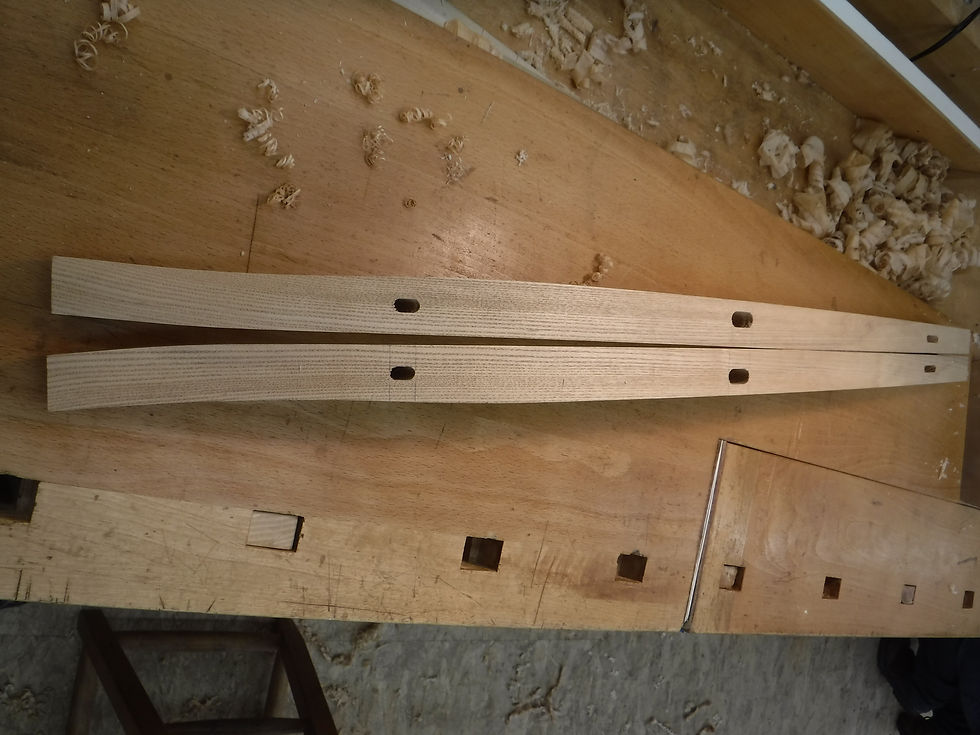Spring 2019: Building Vidar's Chair
- Travis Gran
- Aug 17, 2019
- 3 min read
Updated: Nov 21, 2019
The third course at the school focused on three primary themes: grain graphics, shaping curved work, and mortise and tenon joinery. Out of it all came a chair.
The chair we built, a standard part of the Inside Passage curriculum, was a reproduction of a chair designed by Vidar Malmsten, son of the great Carl Malmsten (considered by many to be the father of Scandinavian furniture design) and close friend to Mr. Krenov. I particularly enjoy this chair for its delicate proportions and graceful curves.
Where to begin? As always, with the wood. I began by choosing a plank of ash. Ash is an excellent wood for chairs: strong, flexible, stable. I chose this particular plank for its tight, straight grain and varying color. Ash is often consistently pale; this plank had an abundance of darker heartwood and some interesting patterns created by minerals that incorporated themselves into the tree as it grew.
The first steps in making the chair centered around grain graphics. As I milled each piece, I paid careful attention to grain direction and orientation. The goal was to create a chair in which the grain graphics follow and compliment each curve.
Following the milling operations, I began shaping the rear legs. Shaping, primarily done with a spokeshave, consumed many quiet hours in the shop. After a few months of steady use, the spokeshave and I became well-acquainted.


.

I found the joinery both intriguing and intimidating. The mortise and tenon joinery begins simply, with a mortise and tenon joint at 90 degree angles. It then increases incrementally in difficulty; in the final stages of the chair, the joinery involves compound angles and curves.


Though the joinery proved a challenge, I found this term to be a little less demanding. Machines were (as always) available only during regular business hours, Monday through Friday. When my next steps required machines, I caught up on some much needed family time. Lara also traveled back to Idaho to see family about halfway through the project. I was able to make significant headway during her absence, easing the number of hours required when she returned.
The most challenging part of the chair for me was the fitting of the back splats and crest rail. Six joints, both ends of the back splats and the ends of the crest rail, had to come together in one assembly. Although most of the joints are cut initially on machines, the final fitting is done by hand. Adjusting one shoulder affected the fit of all the others. I remember one Saturday afternoon: I'd spent hours carefully fitting, and the joints were nearly tight. Then something happened. Did I let my chisel lose its edge? Remove material from the wrong location? Or simply become impatient? I can't say. I remember reassembled the parts, hoping this time I'd see the joints come together with no gaps. Instead, the gaps were much larger. There were gaps where there hadn't been gaps. I put down my chisel and walked down to the pier.
One lesson I'd learned over and over during this year was reinforced again. Good work requires the hand and the eye working together seamlessly, but there's another element more difficult to articulate: the will. The will must also stay in the moment, focused not on the outcome but on the work itself. That Saturday afternoon, I just wanted to see it done. After walking to the pier, I cleaned up and went home. Sunday was a day full of rest and sun and joy and family. I arrived early Monday, focused, patient, attentive. I liked woodworking again. In the quiet of the morning I finished fitting the joints without frustration or fuss.
I finished the chair shortly after. I loved building the chair, and look forward to building another. But in the meantime, Spring had come in British Columbia. It was time to breathe some fresh air and watch the bees pollinate the lavender... Thanks for reading!

Kommentare